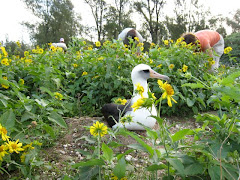 I’m still saturated in salt from this morning. My hair is deliciously knotted into bunches from today’s perfect sequence of events. We motored out to the far side of the emergent reef and snorkeled around Reef Hotel. The corals were purple, the fishes were blue, and the rusty rubbish was everywhere as always. I wanted to stay longer. I wanted to wander the whole atoll, circumnavigate it with my eyes underwater. But we had work to do. Or Kate did anyway. She’s a researcher from Santa Cruz looking at how marine life responds to different levels of sedimentation in various locations around the atoll.
I’m still saturated in salt from this morning. My hair is deliciously knotted into bunches from today’s perfect sequence of events. We motored out to the far side of the emergent reef and snorkeled around Reef Hotel. The corals were purple, the fishes were blue, and the rusty rubbish was everywhere as always. I wanted to stay longer. I wanted to wander the whole atoll, circumnavigate it with my eyes underwater. But we had work to do. Or Kate did anyway. She’s a researcher from Santa Cruz looking at how marine life responds to different levels of sedimentation in various locations around the atoll.We found our GPS location to within a few meters. The sea was choppy, even inside the atoll. Darius, Terry, and Ann jumped in with Kate and dove down to sample the sea floor. Karen and I stayed onboard and got a little seasick in the rough swells. Our anchor got stuck as we tried to leave, but we survived. Then we motored out of Wells’ Harbor, the atoll’s natural opening. Outside the reef, the waves were 3-5 feet swells, crashing hard into the emergent reef. We must have been going 30 knots, slapping the water with our bow. It was rough and wet. We came back past Sand Island and zoomed out the artificial south channel to see Eastern Island, the rusty barge and more birds feeding on the water. When our spines were sufficiently compressed, we returned for lunch.
photo credit: Dani Carter

















No comments:
Post a Comment